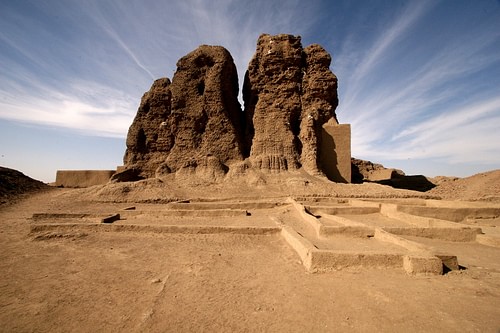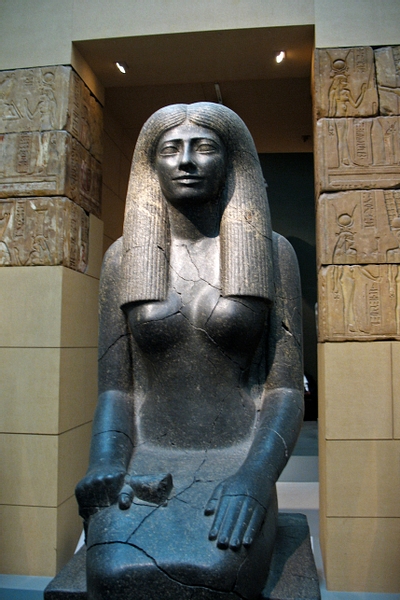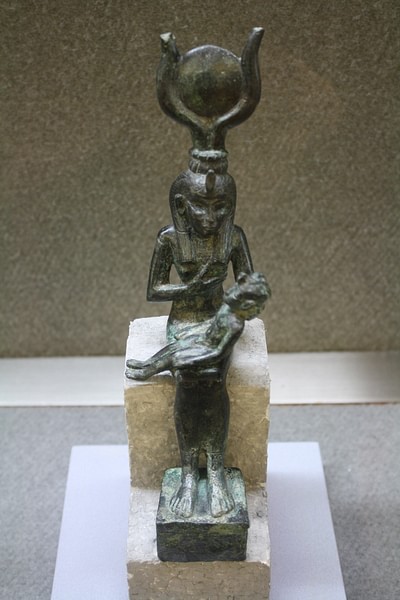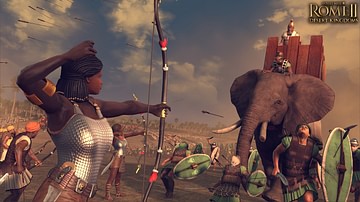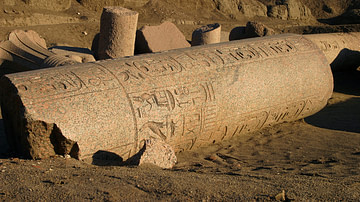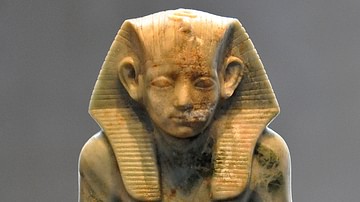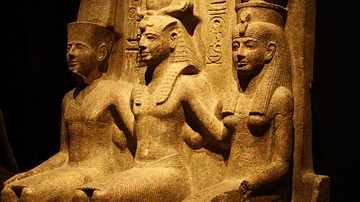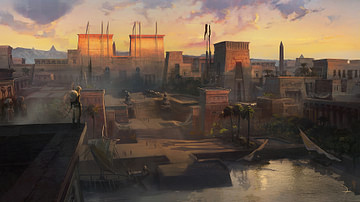The vacillating nature of Ancient Egypt's associations with the Kingdom of Kerma may be described as one of expansion and contraction; a virtual tug-of-war between rival cultures. Structural changes in Egypt's administration led to alternating policies with Lower Nubia, whilst the increasing complexity of Kushite culture provided a serious counterweight to Egyptian dominance. These multigenerational changes impacted the sociopolitical and economic affairs of both societies — today visible in the archaeological record. In this essay, I shall discuss the shifting borders and transformations of Kerma and Egyptian material culture in an attempt to offer some clarity and an original perspective on the complex relationship between these neighboring states.
Introduction
Traditionally, when archaeologists and ancient historians cite an episode of early global interaction, polities such as Phoenicia, Athens or Rome, which are all well fixed in the public consciousness, are commonly cited examples of competitive trade links and cultural exchange. However, to the south of Egypt lies the ancient site of Kerma, a once complex state which engaged in a series of protracted and oscillating relations with pharaonic Egypt. Located on the East bank of the Nile in the lower Dongola Reach, Kerma became the centre of the first Nubian kingdom (the Kingdom of Kerma); with cultural roots arguably extending back into the late-Sudanic Neolithic period (See Kemp 1982: 715; Edwards 2004: 2, 4, 46, 66-67; Bourriau 2000: 208; Morkot 2000: 38). By the early 2nd millennium BCE, Kerma had indeed become 'Egypt's rival' (O'Connor 1993: iii).
In this essay, I will discuss the changing relations between ancient Egypt and Kerma. Synthesizing the two principal chronologies, I have arrived at three specific periods of interaction that I wish to examine: Middle Kingdom Period/Middle Kerma from the reigns of Amenemhat I to Sobekhotep IV (c. 1990-1725 BCE); mid-to-late Classic Kerma during the Second Intermediate Period (c. 1640-1548 BCE); and New Kingdom (post-Classic) Kerma, roughly the reigns of Thutmose I through Horemheb (c. 1502-1302 BCE) (See also Edwards 2004: 80-81, 90, 94, 101-03; Shaw 2000: 480-81; Callender 2000: 172; Bard and Shubert 1999: 54-55; Van Dijk 2000: 308-09). From here, I shall endeavour to illustrate how sociocultural traditions within Kushite and Egyptian societies were influenced by political fluctuations along the Nubian frontier. It should be noted, however, that each of the aforementioned time periods are approximate and fall within broader archaeological constructs which often overlap.
Part I: Middle Kerma
Regional Crossroad
To better understand Egypt's relation with Kerma, it is essential to first know a little about the area which lies between Kush and Upper Egypt, a region that acted as a crossroad in Egyptian-Kerman interrelations. By the reign of Amenemhat I, Lower Nubia was populated by late-Early C-Group (phase Ib) settlements, found at sites such as Dakkeh, Faras and Wawat (Kemp 1983: 127; O'Connor 1993: 35; Edwards 2004: 78, 81, 94; Morkot 2000: 53). Old Kingdom epigraphic evidence, coupled with spatial analysis of cemeteries from Aniba, is indicative of the presence of early Nubian regional rulers (See O'Connor 1993: 32-36; Edwards 2004: 78-79). The exact nature of the political situation is uncertain. However, it has been proposed that these indigenous rulers were initially loyal to the kings of Egypt (See also Morkot 2000: 55; Haag 2003: xiv). For varying reasons, Egypt's relations with Lower Nubia soured and a decision was made to construct a perimeter of colonial fortresses at strategically fixed points, such as Buhen and Qubban, along the Middle Nile region of Wawat (Callender 2000: 151; cf Shaw 2000: 318; Morkot 2003: 88).
One plausible reason behind this southern expansion was to secure commercial interests, especially the gold routes from mines found at (among other places) Darahib, Qareiyat and Umm Nabardi (Lobban 2004: 101-02; Edwards 2004: 78; Garlake 2002: 54; Morkot 2000: 56; Callender 2000: 161; Hayes 1962: 40). In addition, these new settlements would function as centres of trade for both the Egyptian and Nubian populations (Ben-Tor 2007: 53; Edwards 2004: 111). Interestingly, some suggest that Kerma may have been complacent in Egypt's gradual colonization of Lower Nubia with an eye on northern trade (Morkot 2000: 57). Still, others have noted that the evolving political strength of Middle Kerma, compounded with a rising fear of instability along the frontier, forced Egypt's hand in expeditions to the region (Shillington 2005: 762; Lobban 2004: 102). Regardless, the rich gold deposits of southeastern Nubia — essential to Egypt's economic needs — brought Egyptians and Kushites into close contact (See also O'Connor 1982: 905; Callender 2000: 148).
Transitions
By the reign of Senusret I (c. 1971-1926 BCE), Kerma was the foremost city of Upper Nubia, arguably extending sociopolitical hegemony over other contingent centres such as Sai and Bugdumbush (Callender 2000: 161; Edwards 2004: 79; O'Connor 1993: 37-38). The presence of elaborate tombs for their élite members of society demonstrates a high degree of social complexity (Cremin 2007: 102; Shaw et al. 1995: 573; Edwards 2004: 90). This is supported by papyri and other fragmentary evidence which alludes to the existence of a stratified social order complete with a hierarchal civic administration (See Shillington 2005: 762; Grimal 1994: 168-69; Morkot 2000: 59, 61). Whatever the extent of their development, it should be noted that during the Middle Kingdom Period no significant burials of Kushite rulers have been found outside Kerma itself (See also Edwards 2004: 79; O'Connor 1993: 37; Kemp 1982: 715).
Once tenuously established in Lower Nubia (c. 1864-1854 BCE), Egyptian and Nubian interrelations vacillated between belligerence and socioeconomic exchange (See also Bourriau 2000: 208; Callender 2000: 165-166, 174). For example, motifs and painting techniques employed within tombs at Qau el-Kebir, Meir, and an unused specimen from Assiut, hint at artistic influence imported from Kerma culture (Smith and Simpson 1998: 103, 116-17). Equally interesting is Kushite evidence revealing a pan-Egyptian interconnection (O'Connor 1993: 39). For instance, both Upper and Lower Egyptian pottery types are found in Middle Kerma contexts suggesting a long-distance trade network (Ben-Tor 2007: 54). This is supported by Theban papyri that document several transactions between the Egyptian forts of Lower Nubia and indigenous “southern” Kushites of Upper Nubia (Bard and Shubert 1999: 578; Callender 2000: 166). Thus, it may be posited that the Egyptians of the Middle Kingdom were pursuing a fixed trade policy with their Nubian neighbours against a background of fortresses which doubled as cultural exchange centres.
Turning to economic conditions, we can see that infrastructure expanded for the Kushites during the Middle Kingdom period, a fact attested by both the quality and quantity of their grave goods. For instance, at Kerma, affluence is marked by copious burials accompanied by adorned animals, pottery and jewelery (Darnell and Manassa 2007: 97). A rather fascinating observation may be seen in the use of bucrania to surround the deceased in a hemispherical fashion — a custom that was not inexpensive (Edwards 2004: 84, 90-92; Redford 2004: 32). However, not all interaction was trade related. For example, during the reign of Amenemhat III several Egyptian “expeditions” for resources most probably equate to military excursions (Callender 2000: 161). In response to these acts, Kerma city-defences were substantially reinforced with earthworks, such as ramparts and trenches (Kemp 1983: 163; Edwards 2004: 90; Shaw et al. 1995: 584). In summation, out of the material evidence a picture of inter-regional contact between Middle Kerma and the greater Nile Valley begins to form (Smith and Simpson 1998: 117-18).
Part II: Classic Kerma and the Second Intermediate Period
Changing Hands
Following the reign of Sobekhotep IV (c. 1725 BCE), Egyptian sociopolitical order began to fracture. The frontier forts segmented and with the establishment of the Hyksos in Lower Egypt, an ancient multipolarity between the polities of Avaris, Thebes, Wawat and Kerma developed (cf Bourriau 2000: 190; Morkot: 2005: 111-12; Edwards 2004: 95; Levy and Thompson 2010:33). As a result, Kerma began to expand north, with some data suggesting Kushite pillaging and occupation of many Middle Kingdom forts, such as those found at Semna and Kor (Redford 2004: 34; Morkot 2000: 64). At Kerma, this is evidenced by the presence of possible spoils in the form of statues, offering basins, statuettes and seal impressions inscribed with the names of late Middle Kingdom kings (Morkot: 2005: 112; Smith and Simpson 1998: 120; O'Connor 1993: 54). However, some have suggested that these goods are the result of southern trade by the royal courts themselves prior to the devolution of the Middle Kingdom (Edwards 2004: 95; Bourriau 2000: 171, 190). Additionally, Smith (2003b: 80) contends that the traditional accounts of “plundering” by Kushite soldiers are inconsistent with the material evidence. Consequently, the annexation of Wawat by Kerma may have been a much smoother process (See also Bard and Shubert 1999: 578).
For example, cemetery evidence at Mirgissa reveals limited Kerma style burials (Kemp 1982: 755). In contrast, the prodigious degree of Classic period “Egyptian burials” infers that Kerma may have allowed continuity in Egyptian administration, notwithstanding Kushite supervision (See Ben-Tor 2007: 53, 56-57). An interregional partnership seems plausible, perhaps to the degree of semi-autonomy for the former Egyptian colonial forts. At Buhen, this supposition is corroborated by epigraphic evidence which implies that the allegiance of the border forts had shifted from Egypt to Kerma during the early Second Intermediate Period (Edwards 2004: 97; Bourriau 2000: 207). Thus, while Upper Egyptian goods were imported, they were now strictly regulated by commercial policies dictated from Kerma rather than Thebes (See also Bourriau 2000: 207; Ben-Tor 2007: 54).
Exchanging Ideas
Interestingly, we see evidence of Nubianization with Kerma pottery being introduced to the Egyptian expatriates (Morkot 2000: 64). At Askut, for example, the use of Kerma earthenware greatly increases as Egyptian ceramics decrease, suggesting an acculturation by colonial inhabitants (Edwards 2004: 97; Smith 2003a: 57, 60). Broadly, this type of exchange between Egyptians and Kushites in Lower Nubia is a departure from Middle Kingdom contexts that indicate phases Ib-IIa C-Group and Egyptian social segregation (See Edwards 2004: 94). The extent of this interaction was quite widespread however.
For example, epigraphic evidence of Kerma rulers, or heqa, reveals their affinity for Upper Egyptian headdresses; a fashion previously employed by Wawat-Egyptians (Morkot 2000: 54-55, 68). At Kerma and Sha'at, a more prolific case in point is the apparent diffusion of Egyptian mythos in the form of scarabs — sometimes inscribed, other times used as official seals, but often included in burials — which reveal the Kushite adoption of kheper, the Egyptian sacred dung beetle (Ward 1902: 4-5; Ben-Tor 2007: 61-62). For example, an amethyst scarab-pendent found at Uronarti was locally crafted (Bianchi 2004: 62). Hence, something very Egyptian in origin became very Nubian in practice.
The Touch of Egypt
As the city grew, Kerma's infrastructure further benefited from increased contact with Egypt, in turn fostering a more complex cultural centre (Smith 2003b: 82). At the Western Deffufa, we may see an indication of intercommunal acculturation. Rebuilt several times, this magnificent edifice was constructed, sharing certain similarities in base dimensions with Middle Kingdom structures such as the pyramids of the Fayum Oasis and Dahshur (See Connah 2009: 380; Morkot 2000: 66; Lobban 2004: 132; See also Robins 2008: 58; Arnold et al. 2003: 177, 185). The location of this deffufa, in relation to other religious structures and adjacent burials, has given birth to the theory that it was a religious centre (Edwards 2004: 90; Bourriau 2000: 208).
However, the discovery of Semitic copper daggers has led some to believe it functioned as a trading post, while various Second Intermediate Period mud-seals indicate governmental purposes (Harkless 2006: 85; Ben-Tor 2007: 62). To be sure, religious centres where indeed areas of commerce (e.g. Memphis, Thebes, Meroë); this fact, coupled with interpretive issues surrounding Kerma's religious system precludes one from firmly establishing its raison d'être with absolute certainty (cf Prasad 1977: 90-91; Edwards 2004: 110,164-68). Nonetheless, a colossal façade in the form of a pylon plainly betrays Western Deffufa's Egyptian influence (O'Connor 1993: 51, 57; Morkot 2003: 88). Was it crafted by Egyptian expatriates, or planned by Theban advisors? Whatever the case, the continual and active presence of Egyptians in Kerma society is unquestionable. The Interconnections of Kerma, Avaris and Thebes
Despite festering internal problems, ceramics from Lower Egypt were continually imported and utilized by Classic Kerma culture (See Bourriau 2000: 172, 190; Ben-Tor 2007: 54). Concurrently, a certain amount of social integration between Kerma and the Nile Delta polities is visible in the material culture. For example, abundant 'Xios dynastic' mud-seals found at Kerma strongly suggest certain alliances were forged through connubial contracts (See Ryholt and Jacobsen 1997: 113-115; Morkot 2000: 65). Regardless, as during the Middle Kingdom Nubian gold was of principle importance to Egyptian kings thereby necessitating good relations with the now powerful state of Kerma (Bourriau 2000: 201; Mojsov 2005: 55). Separately, Kerma heka sought normalized economic transactions with the Hyksos (See also Bourriau 2000: 186-87, 208; Silverman and Brovarski 1997: 296; Mojsov 2005: 55). Thus, a substantive trade link between Kerma and Lower Egypt developed.
For example, various Semitic bronze items and clay seals bearing the names of Hyksos kings have been found in Classic Kerma strata (Morkot 2000: 65; Kuhrt 1995: 180). Additionally, Tell el-Yahudiya ware (literally “mound of the Jews”) was prolifically used in Nubian tombs, such as those found at Buhen (Henry 2003: 37; Biers and Terry 2004: 93; Smith and Simpson 1998: 117, 120; O'Connor 1993: 138). While in Lower Egypt, elephant ivory became a coveted import from Lower Nubia (Krzyszkowska and Morkot 2000: 324). On the other hand, some have pointed to the disproportionately low number of Kerma ceramics in Lower Egypt as suggesting that trade between the two polities was administratively unregulated (Ryholt and Jacobsen 1997: 140-41). However, this is weak speculation at best.
For example, the high quantity of Egyptian goods in Classic Kerma contexts might just as easily be explained as a result of better logistical capabilities on the part of the Semitic rulers of Lower Egypt. In addition, texts attributed to Kamose (1555-1548 BCE) strongly infer that an economic alliance between the Kushites and Hyksos had been forged to “squeeze out” the Theban kings (See Kuhrt 1995: 180). And there is evidence that this scheme became quite successful too. An example may be the rather meagre design of royal burials in Second Intermediate Thebes — a stark contrast to the affluence displayed in the élite burials of Classic Kerma (See Bryan 2000: 221-23; O'Connor 1993: 54-55). The late Classic K-III tumulus may be a case in point. A variety of 'posh' artifacts and the sheer architectural scope of the tomb itself leave no doubt as to the owner's wealth (O'Connor 1993: 54-57). Moreover, the utilization of a winged sun-disk as funerary décor in its burial chamber reinforces a notion of Egyptian influence (Bard and Shubert 1999: 271; Smith and Simpson 1998: 119). Regardless, as the Second Intermediate Period came to a close, trade between Kerma and Thebes began to thrive (Bourriau 2000: 209).
Part III: New Kingdom Kerma
Reconquest
As we near the end of the reign of Kamose, Lower Egyptian administration was slowly being brought once again under Theban domination. In the reign of Thutmose I (1502-1492 BCE), the fortresses of Wawat had been occupied by a reunited Egypt as the southern frontier was extended further south, beyond the Third Cataract. Under Thutmose II (1492-1479 BCE), Kerma itself was seized and brought under the Upper Egyptian Viceroy of Kush's domain (Bryan 2000: 232, 235; Grimal 1994: 212; Morkot 2000: 70; Edwards 2004: 106). It should be noted here of the role Kushite warriors played in the latter Second Intermediate Theban army and its reconquest of Wawat (Bourriau 2000: 209). Conceivably, Kushites entering into late Second Intermediate Theban rank-and-file could have been an early indication of a breakdown in Kerma administrative capabilities. Whatever the reasons, Kerma was pushed out of Wawat. For example, Theban records describe the brutal defeat of Kerma heka in lurid detail (Bryan 2000: 234). While at Aniba, early New Kingdom epigraphic evidence describes Kushite tributary gifts being given to the new Egyptian pharaohs as they came to be known (Bryan 2000: 224; Atiya and El-Shahawy 2005: 21).
Further Expansion
At this point, so-called “Egyptianization” or perhaps more precisely colonization became more aggressive than in earlier periods (Redford 2004: 38-39). For example, new forts were constructed at Sha'at and as far south as Tumbos in the northern Dongola Reach (Grimal 1994: 212; Redford 2004: 171). At Soleb, a fortified colony was established which ultimately supplanted Kerma as Egypt's capital in Upper Nubia. While another fortress was built at the far-away Fourth Cataract (Bryan 2000: 268; O'Connor 2001: 158; O'Connor 1993: 60; Morkot 2000: 74).
Accompanying the 18th Dynasty forts, new Egyptian temples were constructed throughout the former Kingdom of Kerma, the furthermost along the Fourth Cataract near the frontier bastion of Napata (See also Redford 2004: 49; Edwards 2004: 103, 106; Morkot 2000: 137). Other unique examples can be seen within the heartland of Kush. For example, at Soleb, a grand temple to Amun-Ra was constructed by Amenhotep III (1389-1349 BCE) (O'Connor 2001: 150). Additionally, at Sesibi and Kawa, two temples dedicated to Aten were constructed by Akhenaten (1349-1332 BCE) (Bates 1909: 73; Breasted 1909: 80-82; Janssen 1956: 1345). Moreover, Akhenaton's architectural ventures in Kerma are hinted at from the numerous talatat found at Dokki Gel (Darnell and Manassa 2007: 111). Unique for their use in the rapid building of Akhetaten, these talatat may suggest that a temple to Aten was located at Kerma (Allen 2000: 197). In contrast, radio carbon dating suggests that the indigenous religious structures were abandoned by the Amarna Period suggesting that the socio-religious status of Kerma had declined (Edwards 2004: 102, 110; AEN 2010: 94). It is intriguing to see that the religious reforms of the Akhenaton extended far to the south, proving that Kerma was culturally important even to Egypt's “heretic king”.
Epilogue
I have attempted throughout this essay to highlight aspects of Kerma's alternating relations with Egypt, focusing on areas of contact between Egyptians and Kushites up to the period of Akhenaton. However, one should not assume that the crushing of the Kingdom of Kerma extended to a political domination of Nubia. Some evidence points to perennial Kushite insurgencies, perhaps instigated by Kerma (See Morkot 2000:73, 75, 89; O'Connor 1993: 65-66). Perhaps a more relaxed policy from Egypt invited these uprisings. For example, the sheer size of the cemeteries north of New Kingdom Wawat reflects a clear, if not vast, Egyptian presence (Edwards 2004: 106; Lobban 2004: 372). While in contrast, there are no Egyptian cemeteries south of the Third Cataract (Smith 2003b: 54; cf Edwards 2004: 103).
As in the Middle Kingdom, this may underscore the specific goal behind southern expansion: that being Nubia's rich gold deposits and not a blatant colonization for the purposes of imperialism (Redford 2004: 52-53; O'Connor 1993: 62). If true, Upper Nubian Kushite rulers may have exhibited some autonomy over their respective territories. From here, it could be argued that a subsequent lack of the presence of Egyptian colonial settlements in the south may have exacerbated problems with Kushite rebels - a stark contrast to the effectiveness of the Egyptian administration in Lower Nubia. Regardless, the inconsistent nature of Egypt's long and often tempestuous relationship with Nubia reflects the varying socioeconomic and political problems of different periods. An irony of which may be found in the fact that Kushite culture continued to thrive long after Kerma ceased, culminating in ancient Egypt's 25th Dynasty when a Nubian pharaoh sat on the throne.
Bibliography
AEN 2010. The Archaeology of Egypt and Nubia. School of Archaeology and Ancient History. Leicester: University of Leicester, 2010.
Allen, James P. Middle Egyptian: An Introduction to the Language and Culture of Hieroglyphs. Cambridge: Cambridge University Press, 2000.
Arnold, Dieter. The Encyclopaedia of Ancient Egyptian Architecture (Lexikon der Ägyptischen Baukunst). Ed. Nigel Strudwick and Helen Strudwick. Trans. Sabine Gardiner. English. London: I.B.Tauris, 2003.
Atiya, Farid and Abeer el-Shahawy. The Egyptian Museum in Cairo: A Walk Through the Alleys of Ancient Egypt. Standard. Cairo: Farid Atiya Press, 2005.
Bard, Kathryn A. and Steven Blake Shubert, Encyclopedia of the Archaeology of Ancient Egypt. London: Routledge, 1999.
Bates, William N., ed. "Archaeological News: Notes on Recent Excavations and Discoveries." American Journal of Archaeology: The Journal of the Archaeological Institute of America (Macmillan Co.) VIII (July-December 1909): 73.
Ben-Tor, Daphna. Scarabs, Chronology, and Interconnections: Egypt and Palestine in the Second Intermediate Period. Vol. 27 of Orbis biblicus et orientalis: Series Archaeologica. Fribourg: Academic Press Fribourg, 2007.
Bianchi, Robert Steven. Daily life of the Nubians. First. Westport: Greenwood Publishing Group, 2004.
Biers, Jane C. and James Terry, Testament of Time: Selected Objects from the Collection of Palestinian Antiquities in the Museum of Art and Archaeology University of Missouri-Columbia. Cranbury: Associated University Presses, 2004.
Bourriau, Janine. "The Second Intermediate Period (c. 1650-1550 BC)." The Oxford History of Ancient Egypt. Ed. Ian Shaw. Oxford: Oxford University Press, 2000. 184-217.
Breasted, James Henry. "Second Preliminary Report of the Egyptian Expedition." The American Journal of Semitic Languages and Literatures XXV (1909): 80-82.
Bryan, Betsy M. "The 18th Dynasty before the Amarna Period (c.1550-1352 BC)." The Oxford History of Ancient Egypt. Ed. Ian Shaw. Oxford: Oxford University Press, 2000. 218-71.
Callender, Gae. "The Middle Kingdom Renaissance (2055-1650 BC)." The Oxford History of Ancient Egypt. Ed. Ian Shaw. Oxford: Oxford University Press, 2000. 148-83.
Connah, Graham. "Holocene Africa." The Human Past: World Prehistory & the Development of Human Societies. Ed. Chris Scarre. Second. London: Thames and Hudson, Ltd., 2009. 350-91.
Cremin, Aedeen. Archaeologica: The World's Most Significant Sites and Cultural Treasures. Lan Cove, NSW: Global Book Publishing, 2007.
Darnell, John Coleman and Colleen Manassa. Tutankhamun's Armies: Battle and Conquest During Ancient Egypt's Late Eighteenth Dynasty. Hoboken: John Wiley and Sons, 2007.
Dijk, Jacobus Van. "The Amarna Period and the Later Kingdom (c.1352-1069 BC)." The Oxford History of Ancient Egypt. Ed. Ian Shaw. First. Oxford: Oxford University Press, 2000. 272-313.
Edwards, David N. The Nubian Past: An Archaeology of the Sudan. London: Routledge, 2004.
Garlake, Peter S. Early Art and Architecture of Africa. Oxford: Oxford University Press, 2002.
Grimal, Nicolas Christophe. A History of Ancient Egypt. Malden: Wiley-Blackwell, 1994.
Harkless, Necia Desiree. Nubian Pharaohs and Meroitic Kings: The Kingdom of Kush. Bloomington: AuthorHouse, 2006.
Hayes, William C. Egypt: Internal Affairs from Tuthmosis I to the Death of Amenophis III. Vols. I, II. Cambridge: The Syndics of the Cambridge University Press, 1962.
Henry, Roger. Synchronized Chronology: Rethinking Middle East Antiquity. New York: Algora Publishing, 2003.
Kemp, Barry J. "Old Kingdom, Middle Kingdom and Second Intermediate Period (c. 2686-1552 BC)." Ancient Egypt: A Social History. Cambridge: Cambridge University Press, 1983. 71-182.
Kemp, Barry J. "Old Kingdom, Middle Kingdom and Second Intermediate Period in Egypt." The Cambridge History of Africa: From the Earliest Times to c. 500 BC. Ed. J. D. Fage, Roland Oliver and J. Desmond Clark. Vol. 1. Cambridge: Cambridge University Press, 1982. 658-769.
Krzyszkowska, Olga and Robert Morkot. "Ivory and Related Materials." Ancient Egyptian Materials and Technology. Ed. Paul T. Nicholson and Ian Shaw. Cambridge: Cambridge University Press, 2000. 320-31.
Kuhrt, Amélie. The Ancient Near East: 3,000-330 BC. Vol. I. London: Routledge, 1995.
Levy, Jack S. and William R. Thompson. Causes of War. West Sussex: John Wiley and Sons, 2010.
Lobban, Richard. Historical Dictionary of Ancient and Medieval Nubia. Vol. 10 of Historical Dictionaries of Ancient Civilizations and Historical Eras. Lanham: Rowman & Littlefield Publishing Group, Inc., 2004.
Mojsov, Bojana. Osiris: Death and Afterlife of a god. Malden: Wiley-Blackwell, 2005.
Morkot, Robert G. The Black Pharaohs. London: The Rubicon Press, 2000.
Morkot, Robert. Historical Dictionary of Ancient Egyptian Warfare. Vol. 26 of Historical Dictionaries of War, Revolution, and Civil Unrest. Lanham: Rowman & Littlefield Publishing Group, Inc., 2003.
—. The Egyptians: An Introduction. London: Routledge, 2005.
O'Connor, David. Ancient Nubia: Egypt's Rival in Africa. First. Philadelphia: University of Pennsylvania, 1993.
O'Connor, David. "Egypt, 1552-664 BC." The Cambridge History of Africa: From the Earliest Times to c. 500 BC. Ed. J. D. Fage, Roland Oliver and J. Desmond Clark. First. Vol. 1. Cambridge: Cambridge University Press, 1982. 830-940.
O'Connor, David. "New Kingdom and the Third Intermediate Period (1552-664 BC)." Ancient Egypt: A Social History. First. Cambridge: Cambridge University Press, 1983. 183-278.
O'Connor, David. "The City and the World: Worldview and the Built Forms in the Reign of Amenhotep III." Amenhotep III: Perspectives on His Reign. Ed. David O'Connor and Eric H. Cline. First. University of Michigan Press, 2001. 125-72.
Prasad, Prakash Chandra. Foreign Trade and Commerce in Ancient India. New Delhi: Abhinav Publications, 1977.
Redford, Donald B. From Slave to Pharaoh: The Black Experience of Ancient Egypt. Baltimore: The John Hopkins University Press, 2004.
Robins, Gay. The Art of Ancient Egypt . Second. Cambridge: Harvard University Press, 2008.
Ryholt, K. S. B. and Adam Bülow-Jacobsen. The Political Situation in Egypt During the Second Intermediate Period, c.1800-1550 B.C. Vol. XX of CNI Publications. Copanhagen: Museum Tusculanum Press, 1997.
Shaw, Ian. "Egypt and the Outside World." The Oxford History of Ancient Egypt. Ed. Ian Shaw. Oxford: Oxford University Press, 2000. 314-29.
—. The Oxford History of Ancient Egypt. Ed. Ian Shaw. Oxford: Oxford University Press, 2000.
Shaw, Thurstan, et al., The Archaeology of Africa: Food, Metals and Towns. Vol. 20 of One World Archaeology. New York: Routledge, 1995.
Shillington, Kevin, ed. Encyclopedia of African History. Vol. 1. New York: Taylor and Francis Group, 2005.
Silverman, David P. and Edward Brovarski, Searching for Ancient Egypt: Art, Architecture, and Artifacts from the University of Pennsylvania Museum of Archaeology and Anthropology. Cornell University Press, 1997.
Smith, Stuart Tyson. "Pharaohs, Feasts and Foreigners: Cooking, Foodway and Agency on Ancient Egypt's Southern Frontier." The Archaeology and Politics of Food and Feasting in Early States and Empires. Ed. Tamara L. Bray. New York: Kluwer Academic/Plenum Publishers, 2003a. 39-64.
—. Wretched Kush: Ethnic Identities and Boundaries in Egypt's Nubian Empire. London: Routledge, 2003b.
Smith, William Stevenson and William Kelly Simpson. The Art and Architecture of Ancient Egypt. Third. New Haven: Yale University Press, 1998.
Ward, John. The Sacred Beetle: A Popular Treatise on Egyptian Scarabs in Art and History. Trans. Francis Llewellyn Griffith. London: Harrison and Sons, 1902.

